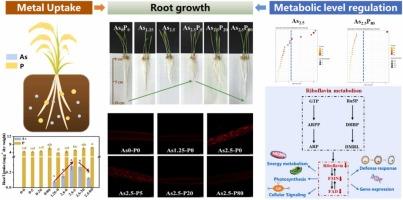Phosphorus counters arsenic phytotoxicity in wheat by activating riboflavin-mediated defense response rather than reducing arsenic accumulation
IF 11.3
1区 环境科学与生态学
Q1 ENGINEERING, ENVIRONMENTAL
引用次数: 0
Abstract
Soil arsenic (As) contamination represents a global concern, as its accumulation leads to crop yield reduction and human health risks through food chain. Although the protective role of phosphorus (P) against As phytotoxicity has been widely documented, underlying mechanisms remained debated. This study systematically investigated the function of P in alleviating As toxicity in wheat Triticum aestivum L. by integrating individual uptake and growth parameters, physiological indices, visualized analysis, and metabolomic response. It was found that P supplementation (80 μm) significantly ameliorated As-induced (2.5 μm) root growth inhibition, oxidative stress, and membrane damage, with relative root elongation increased from 61.4% to 99.3% and MDA content reduced from 6.63 to 3.79 nmol/mg. Notably, under As (2.5 μm) treatment, As accumulation (0.156 to 0.149 mg/g) did not differ significantly with elevated P uptake ranging from 5.32 to 7.46 mg/g in wheat roots, suggesting toxic mitigation effect of P is not by suppressing As uptake. Non-targeted metabolomics revealed As exposure primarily disrupted biological pathways related to amino acids synthesis and activation, accompanied by dysregulation of the involved metabolites, such as arginine, alanine, tryptophan, threonine, and histidine, indicating that nitrogen metabolism disturbance at molecular level shaped the adverse effects at organismal level. Remarkably, these disturbances were eliminated at the highest P level, further supporting the ameliorative effect of P on As toxicity. Concurrently, P upregulated the defense-related riboflavin metabolism pathway, which are essential for multiple fundamental processes of plant. These findings demonstrated that the presence of P helped in counteracting As-induced harm not by limiting uptake but by enhancing stress defense response, thereby advancing our understanding of how P modifies As toxicity.

磷通过激活核黄素介导的防御反应而不是减少砷积累来对抗小麦中的砷植物毒性
土壤砷污染是一个全球关注的问题,因为其积累会导致作物减产,并通过食物链对人类健康构成风险。尽管磷(P)对砷植物毒性的保护作用已被广泛记载,但其潜在机制仍存在争议。本研究通过综合个体吸收和生长参数、生理指标、可视化分析和代谢组学反应,系统地研究了磷在小麦小麦(Triticum aestivum L.)中减轻砷毒性的作用。结果表明,添加80 μm磷显著改善了砷诱导的2.5 μm根生长抑制、氧化应激和膜损伤,根的相对伸长从61.4%提高到99.3%,MDA含量从6.63降低到3.79 nmol/mg。在砷(2.5 μm)处理下,小麦根系中砷的积累量(0.156 ~ 0.149 mg/g)与磷吸收量(5.32 ~ 7.46 mg/g)无显著差异,表明磷的缓毒作用不是通过抑制砷吸收量实现的。非靶向代谢组学发现,砷暴露主要破坏氨基酸合成和激活相关的生物学途径,并伴有相关代谢物如精氨酸、丙氨酸、色氨酸、苏氨酸和组氨酸的失调,表明分子水平的氮代谢紊乱在生物体水平上形成了不利影响。值得注意的是,这些干扰在最高磷水平下被消除,进一步支持磷对砷毒性的改善作用。同时,P上调了与防御相关的核黄素代谢途径,该途径对植物的多个基本过程至关重要。这些发现表明,磷的存在有助于抵消砷诱导的伤害,而不是通过限制摄取,而是通过增强应激防御反应,从而促进我们对磷如何改变砷毒性的理解。
本文章由计算机程序翻译,如有差异,请以英文原文为准。
求助全文
约1分钟内获得全文
求助全文
来源期刊

Journal of Hazardous Materials
工程技术-工程:环境
CiteScore
25.40
自引率
5.90%
发文量
3059
审稿时长
58 days
期刊介绍:
The Journal of Hazardous Materials serves as a global platform for promoting cutting-edge research in the field of Environmental Science and Engineering. Our publication features a wide range of articles, including full-length research papers, review articles, and perspectives, with the aim of enhancing our understanding of the dangers and risks associated with various materials concerning public health and the environment. It is important to note that the term "environmental contaminants" refers specifically to substances that pose hazardous effects through contamination, while excluding those that do not have such impacts on the environment or human health. Moreover, we emphasize the distinction between wastes and hazardous materials in order to provide further clarity on the scope of the journal. We have a keen interest in exploring specific compounds and microbial agents that have adverse effects on the environment.
 求助内容:
求助内容: 应助结果提醒方式:
应助结果提醒方式:


